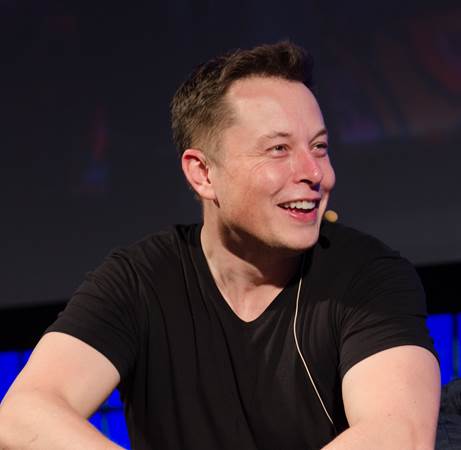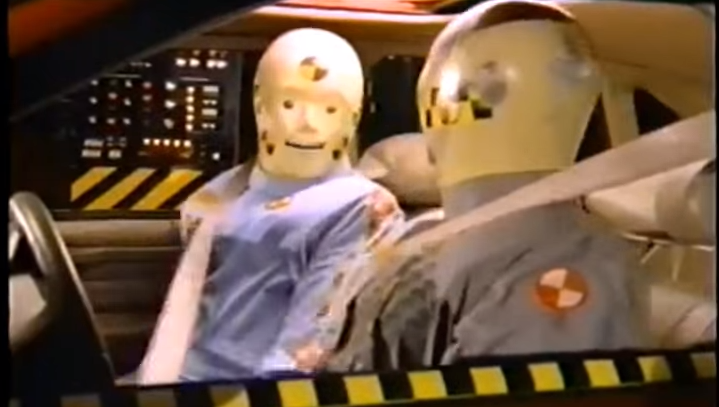Even the auto community has been surprised by the rapid rate of speed at which the autonomous car craze is moving. Consumers may not be wild about the prospects of their rides driving themselves to the office and back, but carmakers are moving quickly and investing heavily in this space.
And the road to autonomous driving became a little smoother last week when the National Highway Travel Safety Administration gave the green light to Google’s self-driving technology. The NHTSA noted it would “interpret ‘driver’ in the context of Google’s described motor vehicle design as referring to the SDS (self-driving system), and not to any vehicle occupants.”
(BTW the NHTSA also gave us the iconic Vince and Larry pictured above, the funny crash test dummies who became famous in PSAs a couple of decades ago. Now on display at the Smithsonian, perhaps they’ll make their return in autonomous driving PSAs of the future.)
So even without a human driver, the system is actually driving the vehicle. This means these Google autonomous cars can now pass the Federal Motor Vehicle Safety Standards test. And the Federal Government is all in. The Transportation Department recently announced a $4 billion decade-long plan to speed up the progress of autonomous cars. Obviously, there are insurance and liability issues that will need to be sorted out. But for media providers in cars, this signals the beginnings of a new dashboard paradigm.
 Not surprisingly, Tesla is playing a lead role in the movement. Amazingly, they sent a “software update” to Model S owners last month (now that’s progress), providing new self-parking capabilities. And the company’s innovative CEO Elon Musk claimed that the Tesla autopilot feature is “probably better than a person right now (at driving).”
Not surprisingly, Tesla is playing a lead role in the movement. Amazingly, they sent a “software update” to Model S owners last month (now that’s progress), providing new self-parking capabilities. And the company’s innovative CEO Elon Musk claimed that the Tesla autopilot feature is “probably better than a person right now (at driving).”
By the way, just the fact that technical updates can be downloaded to cars is a major advancement. Consider that it used to take 3-5 years for automakers to provide any new features. And even in recent times, you had to return to your dealer for updates or use a flash drive. Across the industry in the near future, new features, updates, and functions will be no more complex, time consuming, or inconvenient to install than updating apps on your smartphone.
Back to autonomous, at CES, we attended a number of presentations and keynotes by automakers, all pointing to billion dollar investments in self-driving cars. Clearly, this technology will have a long-term impact on many business categories.
The stated goal by many car execs is to create an accident-free world. Others note that seniors and those with special needs will have more reliable and safe transportation. But there will be serious impacts from autonomous technology that will disrupt many other industries. From auto insurance companies to collision shops to car dealers themselves whose service bays are major profit centers, many business categories will be affected by autonomous.
And then there’s radio, because a car that handles the heavy lifting frees up a “driver’s” focus and concentration level. Predictions vary about the degree to which consumers will be able to use their eyes to read email or watch videos while they drive. Until autonomous cars hit critical mass on our highways and main streets, we won’t know their effect on in-car media like radio. But the OEMs and Tier 1s are busily researching that media future.

Chris Andrews, Visteon’s Leader of Emerging Technologies, told us that if you’re taking a freeway “and the car is doing the driving, there are parts of that drive where theoretically, you’ll be able to do other things.”
And to that point, Volvo exec Andres Tylman- Miikiewicz, envisions the day that video will join radio as a dashboard medium.
GM’s Director of User Experience, Dan Kinney, takes a more guarded stance, observing that autonomous is in the formative stages, but even with self-driving vehicles, “You’re in the car and you need to have responsibility for that.”
However this takes shape in the coming years, the shift in radio usage that we’re already seeing taking place in connected cars will continue to put pressure on media content creators to stay relevant. With autonomous, the in-car game will change even more, making it essential for radio brands to produce and create programming that is crafted to a very different kind of commute.
How will radio fit into this new environment? What advancements in on-demand programming, video production, embedded mobile apps, and inclusion in dashboard ecosystems like Ford SYNC, Android Auto, and Apple CarPlay will have to be planned and implemented?
Radio may need its own Car Czar to focus on technology, programming, marketing, communications, and sales technologies that will keep the industry as vital in the car as it was back in the days of two knobs-six preset factory installed radios. It has also become clear the NAB and RAB each have gaping opportunities to provide guidance, leadership, and insights to broadcasters who continue to struggle to get their heads around the changing automotive space.
Autonomous driving is another in a series of automotive disruptors that challenges radio to make the right calls before this technology moves even further down the highway. Between companies like Apple and Google, self-driving cars, and improving dashboard ecosystems, the learning curve gets steeper by the month.
For radio to maintain its primacy in cars, big initiatives will need to be launched, implemented, and brought to fruition. It will take a lot of work and investment, but for the radio industry, there’s a lot at stake.
Let’s drive.
- Can Radio Afford To Miss The Short Videos Boat? - April 22, 2025
- Media And Technology In 2025: Believe It Or Not! - April 18, 2025
- In Radio, You Just Never Know - April 17, 2025





So well said! “…..we’re already seeing taking place in connected cars will continue to put pressure on media content creators to stay relevant. With autonomous, the in-car game will change even more, making it essential for radio brands to produce and create programming..” So what are we waiting for?
Clark http://www.broadcastideas.com
Thanks, Clark!
The other day I hit a deer taking it’s life, and Causing $1,400 In damage to the car. I had no warning, I didn’t even have time to think about swerving it was simply their. Unlike a human Driver, Google’s driverless cars use LIDAR and it would have detected the the presence of this deer, and we would have most likely avoided this accident. In the big picture view drive-less cars can be made safer than humans drivers, not just as good, but better. It’s not like humans were born to drive, the issue facing google driverless cars and other driverless systems is a testament to that fact. Driverless cars are not just a good idea they are the right thing to do for the right reasons. The most constructive goal of a car is getting you and your stuff from point A to Point B, anything else you can build your own roads for.
James, thanks for the scary story and the observations. When you talk to automakers, they’ll tell you that it is easy to make autonomous cars safe 95% of the time because under normal driving conditions, it’s not a tough task for these vehicles to perform the basic tasks. It is situations like the one you endured where the technology is put to the test. And as you noted, a well-engineered autonomous car would have very likely been safer than a human behind the wheel. The automakers profess to be working toward a goal of accident-free driving, and they will very likely come close. For seniors and people with special needs, this will be a godsend. For the radio industry, it will another very big fork in the road. Appreciate you taking the time.